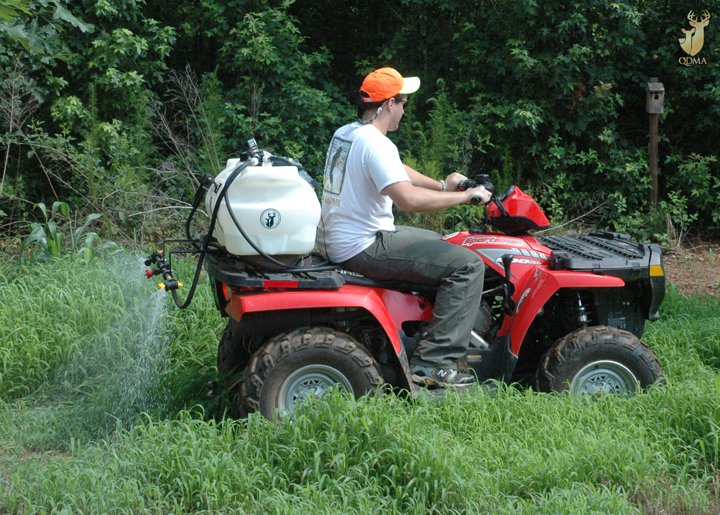Over the last 30 years, no other herbicide has proved as useful to corn and soybean farmers and deer managers as glyphosate, the active ingredient in Roundup®. Glyphosate and Roundup Ready® technology have simplified weed management, providing broad-spectrum, low-cost weed control with very little risk to the environment or human health. Prior to Roundup Ready technology, glyphosate was used primarily as a complete burn-down herbicide for no-till plantings of corn and soybeans, which reduced fuel and labor. This technique also reduced the number of applications of herbicide as well as the total number of acres sprayed. Glyphosate, a post-emergence herbicide, was also tank-mixed with soil-active herbicides, increasing the herbicide diversity, which in turn helped prevent glyphosate-resistant weeds.
Since then, however, glyphosate has been used extensively, and over time a group of glyphosate-resistant weeds has resulted. Herbicide resistance appears in roughly the same way that disease-causing bacteria in humans can attain resistance to certain antibiotics. Genetic mutations can result in strains of weeds that are naturally resistant to a particular herbicide, and this strain survives after application, with no further competition from non-resistant weeds. If the same herbicide is repeatedly used with no other weed-control methods, the resistant population grows and spreads.
The problem is becoming more prevalent throughout the country since farmers and deer managers rely heavily on glyphosate for burn down and application on Roundup Ready crops. The weeds that are most likely to develop resistance or immunity usually exhibit a broad genetic diversity, produce large amounts of seed, germinate through a longer period of the growing season and thrive in poor growing conditions. Resistance is not usually recognized until it has occurred in at least 30 percent of the weed population in a field.
The likelihood of resistant weeds developing in a given location varies with the weed species present, the intensity of glyphosate herbicide use, and the rate in which the herbicide was applied. Increased intensity of glyphosate use increases the likelihood of finding a herbicide-resistant weed. With this continued herbicide use the number of resistant plants will continue to multiply and likely develop a resistant population. Exceeding the recommended herbicide rate and the maximum number of applications during the season will eventually lead to discovery of a resistant weed species. This is why you will always see me urging readers to follow the label closely!
Unfortunately glyphosate resistance is here to stay. Farmers and deer managers must change weed management practices to avoid overuse of glyphosate and reduce the risk of developing resistant weed species. Charles Armstrong, a chemical crop consultant with Agriliance AFC in Alabama, insists that farmers have become too dependent upon glyphosate and Roundup Ready technology. He recommends you rotate between Roundup Ready and conventional crops, use glyphosate with different herbicides that have different modes of action, and most importantly apply a pre-emergence residual herbicide before the use of glyphosate. Also, avoid making more than two glyphosate applications to a field over a two-year period and always consider cultivation and other mechanical weed management practices.
After returning to the Southeast from Texas, I implemented an aggressive Roundup Ready program to aid in cleaning up weedy fields infested with sicklepod, johnsongrass, nightshade and morning-glory. Initially I became dependent on glyphosate for chemical weed control while abandoning a pre-emergence program. In the early 2000s, I watched glyphosate-resistant Palmer pigweed and johnsongrass become more widespread on the farms I manage in west central Georgia, forcing me to diversify my weed-management program. My program now includes an aggressive combination of tillage practices and both pre- and post-emergence herbicides with different chemistry and modes of action.
My experience with glyphosate brings me to another conclusion: Poor herbicide effectiveness is usually a result of environmental factors and/or improper application. The majority of cases where weeds “escape” control efforts in Roundup Ready crops do not result from resistance but from improper application. Mistakes include incorrect rate for the size weed and/or the species targeted, rainfall after application before the weeds have absorbed the herbicide, drought- or cold-stressed weeds, and incomplete spray coverage.
Deer managers tend to think that more is better, especially when it comes to seed, fertilizer and herbicide. University trials have proven that deviating from the chemical manufacturer’s recommended label rate can cause multiple problems. Applying higher rates can cause crop damage, while applying reduced rates can cause poor weed control leading to yield loss and ultimately an increase of weed seed banks. It is important for managers to carefully read and understand herbicide labels prior to application. If you are not confident in your ability to successfully apply herbicides, hire a trained herbicide applicator to ensure proper applications. Be sure to also contact your local county extension agent or chemical consultant to discuss herbicide options to combat resistant weed species and prevent the spread of herbicide-resistant weeds.
Problem Species
The known species that have developed glyphosate-resistant populations include common and giant ragweed, horseweed, Palmer pigweed, Italian ryegrass, tropical spiderwort, water hemp, johnsongrass, annual bluegrass, and others. This does not mean that every time you encounter one of these species, it is glyphosate-resistant. Instead, genetic strains of these species have developed resistance and have become a problem in certain areas of some states. To view an updated list of glyphosate-resistant species and where they occur, click here.
About the Author: Brian Sheppard is a food plot consultant from Georgia and owner of Wildlife Landscape Services. This is one of several articles he has contributed to QDMA’s Quality Whitetails magazine.
